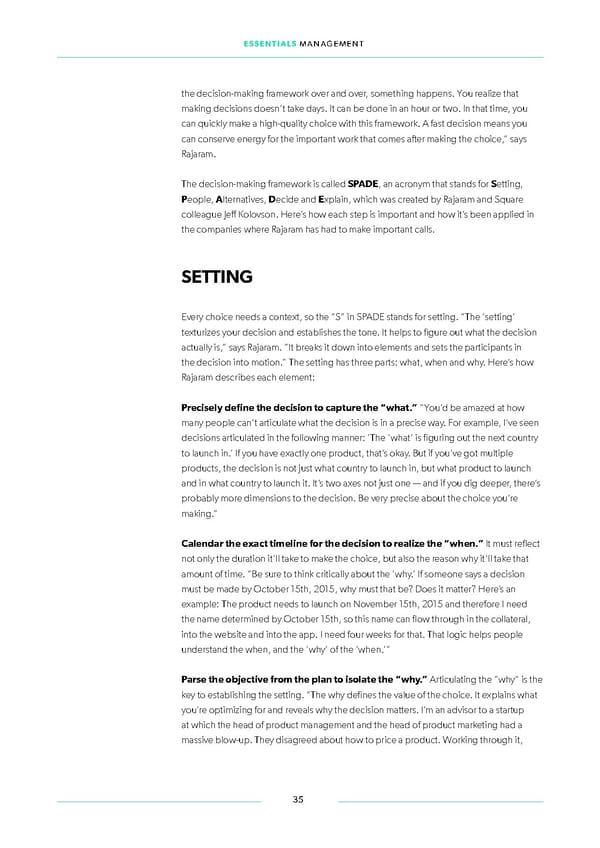ESSENTIALS MANAGEMENT the decision-making framework over and over, something happens. You realize that making decisions doesn’t take days. It can be done in an hour or two. In that time, you can quickly make a high-quality choice with this framework. A fast decision means you can conserve energy for the important work that comes atfer making the choice,” says Rajaram. The decision-making framework is called SPADE, an acronym that stands for Setting, People, Alternatives, Decide and Explain, which was created by Rajaram and Square colleague Jeff Kolovson. Here’s how each step is important and how it’s been applied in the companies where Rajaram has had to make important calls. SETTING Every choice needs a context, so the “S” in SPADE stands for setting. “The ‘setting’ texturizes your decision and establishes the tone. It helps to ifgure out what the decision actually is,” says Rajaram. “It breaks it down into elements and sets the participants in the decision into motion.” The setting has three parts: what, when and why. Here’s how Rajaram describes each element: Precisely deifne the decision to capture the “what.” “You’d be amazed at how many people can’t articulate what the decision is in a precise way. For example, I’ve seen decisions articulated in the following manner: ‘The ‘what’ is ifguring out the next country to launch in.’ If you have exactly one product, that’s okay. But if you’ve got multiple products, the decision is not just what country to launch in, but what product to launch and in what country to launch it. It’s two axes not just one — and if you dig deeper, there’s probably more dimensions to the decision. Be very precise about the choice you’re making.” Calendar the exact timeline for the decision to realize the “when.” It must relfect not only the duration it’ll take to make the choice, but also the reason why it’ll take that amount of time. “Be sure to think critically about the ‘why.’ If someone says a decision must be made by October 15th, 2015, why must that be? Does it matter? Here’s an example: The product needs to launch on November 15th, 2015 and therefore I need the name determined by October 15th, so this name can lfow through in the collateral, into the website and into the app. I need four weeks for that. That logic helps people understand the when, and the ‘why’ of the ‘when.’” Parse the objective from the plan to isolate the “why.” Articulating the “why” is the key to establishing the setting. “The why deifnes the value of the choice. It explains what you’re optimizing for and reveals why the decision matters. I’m an advisor to a startup at which the head of product management and the head of product marketing had a massive blow-up. They disagreed about how to price a product. Working through it, 35
 Essentials Management First Round Capital Page 34 Page 36
Essentials Management First Round Capital Page 34 Page 36